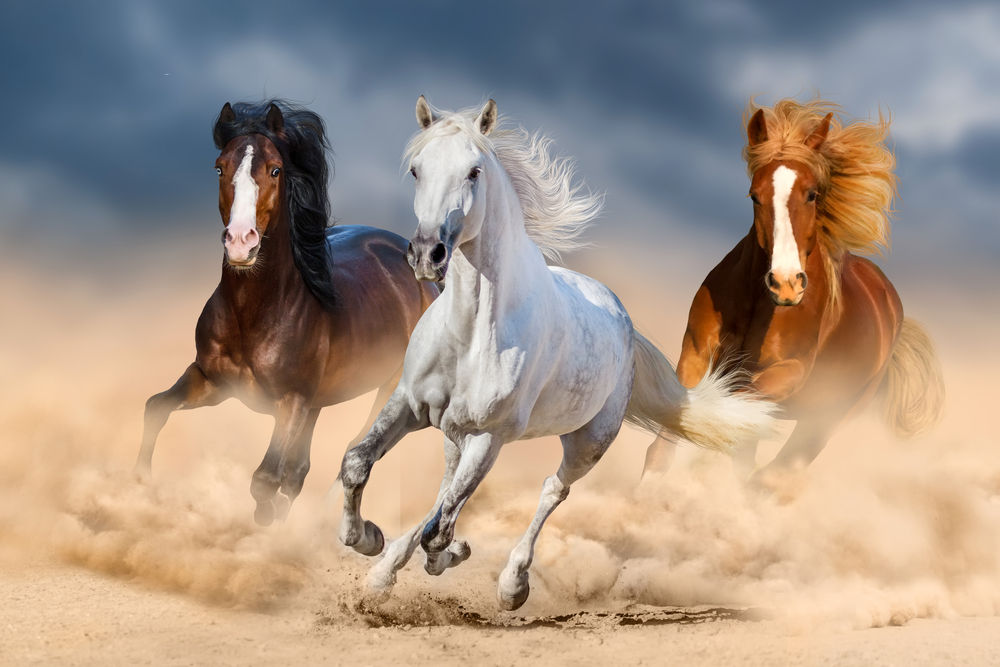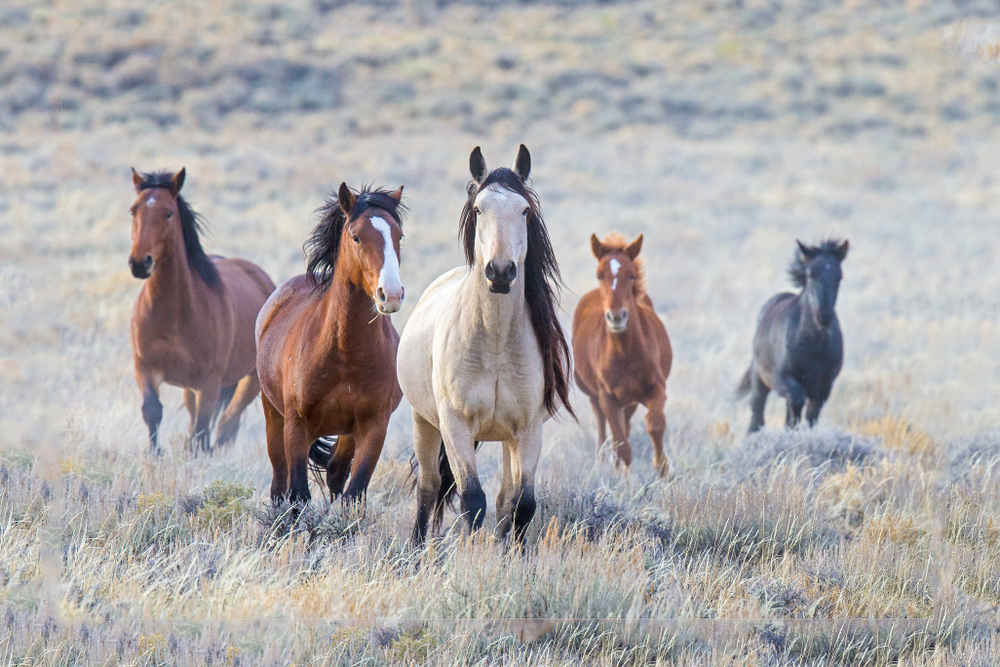- Your source for stall mats, rubber arena footing, arena harrows and arena dust control.

Some people think of mustangs as male horses, while others think of them as female horses. So, who is right? Are mustang horses male or female? Continue reading to learn more.
Mustang horses can be either male or female, as ‘mustang’ refers to the breed of the horse and not the gender. Male mustang horses can be called stallions, studs, or geldings; Whereas, female mustang horses can be called mares or fillies. Baby mustangs of either sex are called foals.
So, how do we know when to call a male or female horse by a certain name? Continue reading to find out how.
Are Mustang Horses Male Or Female?
What comes to mind when you hear the word mustang? Besides the classic automobile that has garnered cult status, is there anything that comes to mind when you hear the word “mustang” in the context of horses? There is a good chance you imagine mustangs as male horses; after all, the word has such a macho ring to it.
On the other hand, you could be one of the people who believe mustangs are female horses. So which is it? Are Mustangs male or female? It might surprise you to learn that mustangs can be either male or female. ‘Mustang’ does not refer to the horse’s gender; instead, it refers to the breed.
Thus, the next time you hear someone talk about mustangs, think breed, not gender. Modern-day mustangs are descendants of Colonial Spanish horses brought to the Americas from the Spanish. It might be interesting to know that the first Spanish horses to set foot in the Americas were introduced by Christopher Columbus in 1493.
Over time, these horses intermingled with other horse breeds and types, resulting in the mustang we know of today. Although mustangs come in various body types and coat colors, they all share an outstanding ability to navigate rough or challenging terrain and excellent endurance.
Many people mistake these horses for wild horses. And while envisioning a mustang galloping over the countryside with the wind rushing through its mane may appear wild, they are anything but.
In fact, the proper term for these horses would be feral as they have derived from domesticated horses. I think most people will agree that ‘Feral horses’ doesn’t have the same ring as ‘wild horses.’ Regardless of the label used to refer to mustangs, they are beautiful, iconic animals with a fascinating history.
What Is A Male Mustang Called?
A mature, adult, mustang male horse is called a stallion. This is true for other horse breeds too. ‘Stallion’ is the name given to horses of the masculine form. However, not all male horses are called stallions, as there are certain exceptions.
For example, whether the horse is castrated or is used for breeding purposes. But that’s something we’ll talk about later. The stallion is typically stronger, faster, bigger, and better built than its female counterpart. Stallions are also well known for having a well-defined and curved crest on their necks.
However, when dealing with stallions, it is best to be cautious. Stallions can have a temperamental nature and exhibit more aggression than their counterparts. This can make them extremely difficult to manage if you are an inexperienced horse handler. In contrast, horses that are castrated are called geldings.
These horses will typically exhibit the same characteristics as other castrated animals.
For instance, decrease in testosterone, better temperament, more gentleness, etc. As a result of the nature of geldings, they have become a favorite among horse handlers and equestrians alike.
Their appeal stems primarily from working purposes as they are calmer, easier to train, and easier to handle. We can also call some male horses ‘studs.’ However, this name is only reserved for stallions used for breeding purposes.

What Is A Female Mustang Called?
Like other horse breeds, a female mustang is called a mare. Interestingly, mares are not only used to refer to female horses; mares can also be used to refer to females of other equine animals such as zebras and donkeys.
Besides the obvious sexual reproductive parts, there is one other factor that defines an equine animal as a mare; age. Female horses over the ages of 3 or 4 years old are called mares.
Any younger and these horses are referred to using a different name – a filly. Although fillies can be sexually mature, breeding should be delayed until they reach an older age, such as four or five years old.
Mares are generally considered to have an even temperament. However, they have been known to have behavioral changes and become temperamental during heat. For this reason, many people prefer geldings over both mares and stallions.
What Is A Baby Mustang Called?
Mustang horses under the age of one of either sex are called foals. Foals are generally used to refer to young horses, but you can also apply it to young donkeys as well. Mustang foals are typically born in April, May, or early June after a gestation period of 11-months.
Horses (mustang horses included), between the ages of one and two, and of either sex are called yearlings. In the case of yearlings, you can also assign a name used to refer to their gender—for instance, a yearling colt.
“Colt” is used to describe any male horse under the age of four. So a yearling colt would mean the horse is between one and two years of age and is a male. Yearlings could be compared to pre-adolescents and are not fully developed.
Conclusion
We have established that mustang horses are a breed of horse and can have either sex, male or female. However, mustangs can be referred to by different names based on their age and sex.
Male mustangs can be called stallions, studs, geldings, or colts. Female mustangs can be called mares or fillies. And young mustang horses of either sex can be called foals or yearlings. Regardless of their names, mustangs are beautiful horses you can’t help but notice.


